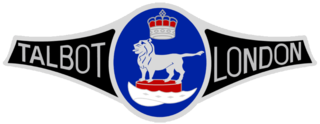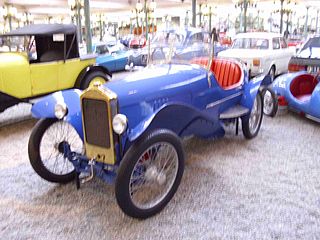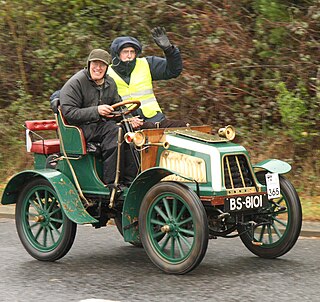
Panhard was a French motor vehicle manufacturer that began as one of the first makers of automobiles. It was a manufacturer of light tactical and military vehicles. Its final incarnation, now owned by Renault Trucks Defense, was formed by the acquisition of Panhard by Auverland in 2005, and then by Renault in 2012. In 2018 Renault Trucks Defense, ACMAT and Panhard combined under a single brand, Arquus.

L'Aster, Aster, Ateliers de Construction Mecanique l'Aster, was a French manufacturer of automobiles and the leading supplier of engines to other manufacturers from the late 1890s until circa 1910/12. Although primarily known as an engine mass manufacturer the company also produced chassis for coach-works and a complete range of components.

Ballot was a French manufacturer, initially of engines, that also made automobiles between 1919 and 1932. Édouard Ballot became well known as a designer of reliable engines. He helped Ettore Bugatti in developing his first engines.

Delage is a French luxury automobile and racecar company founded in 1905 by Louis Delâge in Levallois-Perret near Paris; it was acquired by Delahaye in 1935 and ceased operation in 1953.

E. R. Thomas Motor Company was a manufacturer of motorized bicycles, motorized tricycles, motorcycles, and automobiles in Buffalo, New York between 1900 and 1919.

Léon Bollée Automobiles was a French company founded by Léon Bollée in Le Mans to build a first vehicle called "Voiturette".

The Renault Voiturette was Renault's first ever produced automobile, and was manufactured between 1898 and 1903. The name was used for five models.
The first Voiturettes mounted De Dion-Bouton engines. Continental tires were used for the car, a make still used for several modern Renaults today.
Buchet was a French motorcycle and automobile manufacturer between 1899 and 1930.
The 1906 Grand Prix season is regarded as the first Grand Prix racing season. It marked the advent of two iconic races: The French Grand Prix and the Targa Florio.

The 1908 Grand Prix season was the third Grand Prix racing season. An international economic recession affected motor-racing with fewer races and smaller fields. However, in consequence, it also saw an increase in the number of smaller cars and voiturette racing. This gave close racing between the teams from Lion-Peugeot, Sizaire-Naudin and Delage. Both the major races in Europe, the Targa Florio and French Grand Prix, had precursor voiturette races, and along with the Coupe des Voiturettes, the honours were shared between those three manufacturers. This year’s Targa Florio had a small, but quality, field. Vincenzo Trucco won for Isotta-Fraschini with better mechanical reliability, after a close duel with the FIATs of Felice Nazzaro and Vincenzo Lancia.

The 1909 Grand Prix season was the fourth Grand Prix racing season. There were no Grandes Épreuves that year, as the economic recession of the previous year continued on. Renault had withdrawn from motor-racing and a number of French manufacturers, falling behind the success of their German and Italian rivals, followed suit. The French Grand Prix was cancelled, leaving the Targa Florio in Italy and Vanderbilt Cup in the United States as the only major races this season. With so little competition and financial incentive, technological advances ground to a halt. Emphasis shifted from racing to setting speed and endurance records. Benz & Cie built a new 12.4-litre racing-engine, and its 200 bhp derivative was put into the Blitzen Benz. This 21.5-litre monster held the Land speed record from 1909 to 1922, with various drivers starting with Victor Hémery in November, 1909 at Brooklands.

Corre La Licorne was a French car maker founded 1901 in Levallois-Perret, at the north-western edge of central Paris, by Jean-Marie Corre. Cars were produced until 1947.

Clément-Talbot Limited was a British motor vehicle manufacturer with its works in Ladbroke Grove, North Kensington, London, founded in 1903. The new business's capital was arranged by Charles Chetwynd-Talbot, shareholders included automobile manufacturer, Adolphe Clément, along with Baron Auguste Lucas and Emile Lamberjack, all of France.

The Bignan was a French automobile manufactured between 1918 and 1931 on the north side of central Paris, in Courbevoie. The business was created, and till the mid 1920s-headed up, by Jacques Bignan.

Belga Rise was a Belgian automobile manufacturer, based in Haren, Brussels, specializing in luxury cars.

Sizaire-Berwick was an Anglo-French automobile manufacturer active between 1913 and 1927.

Sizaire Frères was a French automobile manufacturer established by the brothers Maurice (1877–1970) and Georges Sizaire (1880–1924) in 1920, and producing cars between 1923 and 1929.

Sénéchal was a French automobile manufacturer between 1921 and 1929.

Automobiles Darracq France was a manufacturer of motor vehicles and aero engines in Suresnes, near Paris. The enterprise, known at first as A Darracq et Cie, was founded in 1896 by successful businessman Alexandre Darracq.

Lacoste & Battmann, Lacoste et Battmann, was a French manufacturer of automobiles, based in Paris, from 1897 until 1913.




















